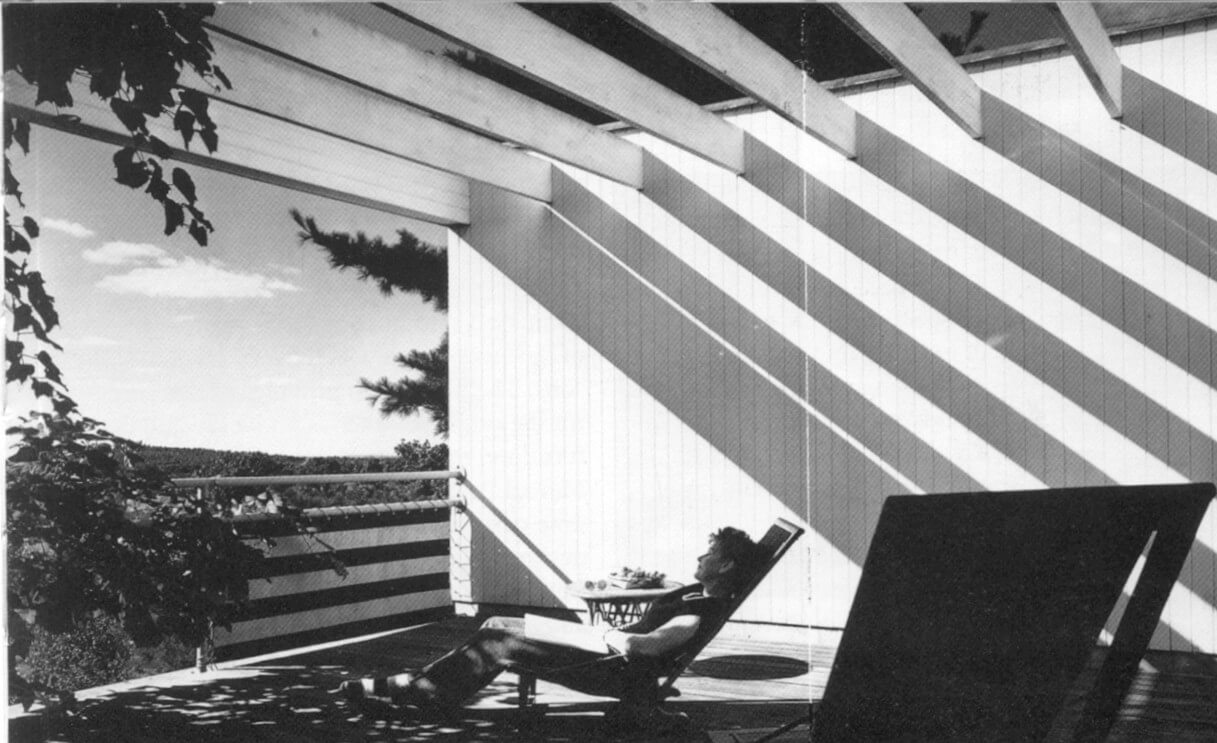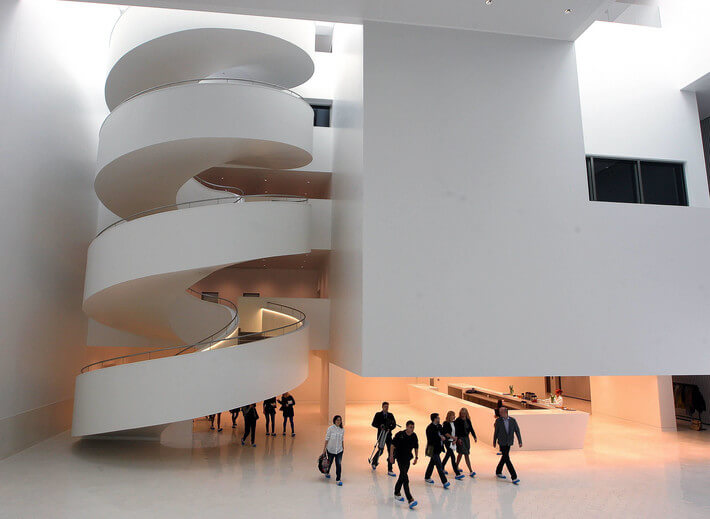Using simple forms and natural light, Polish studio Sarna Architekci is known across Europe, Africa and the Middle East for modern, minimalist interiors. Designing for both commercial and residential projects, they create useful spaces with clean aesthetics that deliver on functionality and beauty. For our third Voice of an Architect feature, we speak with architect, interior designer and studio co-owner Diana Sarna, pictured below, about inspirations, creations and transformations.
 Who and what inspires you?
I am inspired by Walter Gropius, a German architect who shared his knowledge and experience as the head of the Bauhaus art school in 1919. His approach to architecture is timeless and I hope it will never devalue. According to him, good architecture should reflect life itself, which assumes in-depth knowledge of biological, social, technical and artistic issues. I understand it as applying the concept of eco-architecture and when it is impossible due to high costs, applying the low-tech concept. This is worth remembering in our time of climate change.
Besides icons of architecture, I am also inspired by anonymous buildings and details spotted while simply going somewhere; the vast municipal space and a spectacle of light that takes place there. I am inspired every day by what you can do with a pencil and design software, by the history of art and stories of investors, by the atmosphere of the office and my own home.
Who and what inspires you?
I am inspired by Walter Gropius, a German architect who shared his knowledge and experience as the head of the Bauhaus art school in 1919. His approach to architecture is timeless and I hope it will never devalue. According to him, good architecture should reflect life itself, which assumes in-depth knowledge of biological, social, technical and artistic issues. I understand it as applying the concept of eco-architecture and when it is impossible due to high costs, applying the low-tech concept. This is worth remembering in our time of climate change.
Besides icons of architecture, I am also inspired by anonymous buildings and details spotted while simply going somewhere; the vast municipal space and a spectacle of light that takes place there. I am inspired every day by what you can do with a pencil and design software, by the history of art and stories of investors, by the atmosphere of the office and my own home.

 What is your favourite building and why?
The Philharmonic Hall in Szczecin, Poland. The building is a true spectacle. Soaring to the sky, it is a white edifice that distinguishes itself from other city buildings. Light, pointed segments of the elevation of the new edifice are right next to the old brick buildings erected in the 19th century and at the beginning of the 20th century. There is nothing about blending with the precincts or imitating historical buildings.
The Spanish architectural firm, Studio Barozzi Veiga, who won the international competition to design the Philharmonic Hall, presented a brave and clear-cut building. Tradition and local heritage is reflected in division of the edifice into vertical segments, each of which is capped with a gable roof. Similar height, size, divisions – this is a bow to the history of the place. In the investor’s description you can read: “The object is to be built on the principle of interconnected elements: white, crystal boxes with pointed roofs, which will create a homogeneous and compact shape, with a uniform appearance day and night.”
The Philharmonic Hall in Szczecin stands out not only because of its white, shining, glass elevation that disperses the light, it is also an extraordinary interior which, apart from acoustic and functional values, stands for quality itself.
What is your favourite building and why?
The Philharmonic Hall in Szczecin, Poland. The building is a true spectacle. Soaring to the sky, it is a white edifice that distinguishes itself from other city buildings. Light, pointed segments of the elevation of the new edifice are right next to the old brick buildings erected in the 19th century and at the beginning of the 20th century. There is nothing about blending with the precincts or imitating historical buildings.
The Spanish architectural firm, Studio Barozzi Veiga, who won the international competition to design the Philharmonic Hall, presented a brave and clear-cut building. Tradition and local heritage is reflected in division of the edifice into vertical segments, each of which is capped with a gable roof. Similar height, size, divisions – this is a bow to the history of the place. In the investor’s description you can read: “The object is to be built on the principle of interconnected elements: white, crystal boxes with pointed roofs, which will create a homogeneous and compact shape, with a uniform appearance day and night.”
The Philharmonic Hall in Szczecin stands out not only because of its white, shining, glass elevation that disperses the light, it is also an extraordinary interior which, apart from acoustic and functional values, stands for quality itself.
 What is your favourite project you have worked on and why?
The office space for Becton Dickinson & Company Research Centre Ireland, Limerick, Ireland. It was not a standard design of the interior – my design team had to fit the building into the already existing one. We found the solution in containers. We saw potential in the problem posed by the existing hall and the needs and requirements of the investor; architecture means taking decisions depending on possibilities.
Do you have a favourite quote?
"Design is not just what it looks like and feels like. Design is how it works." Steve Jobs
What is the most satisfying part of being an architect?
I feel satisfaction when I observe how a concept is transforming into something real and then when the created space takes the helm and informs its users.
How would you describe your design philosophy?
Two words: creativity & responsibility.
Creativity, because I am close to the philosophy of Osho, who said that creativity is a form of rebellion. Thus, I rebel by finding inapparent applications of materials by experimenting with form and texture, while at the same time being faithful to a strict concept of simple forms.
Responsibility, because my foundation is listening to the investor’s needs, getting to know their habits, and then leading them through a maze of materials available on the market and selecting the perfect ones that are suitable for the concept I referred to earlier.
Image 2: Diana Sarna of Sarna Architekci.
Images 3 & 4: Gropius House (Lincoln, US) by Walter Gropius, 1938
Images 1 & 5: The Philharmonic Hall (Szczecin, Poland) by Estudio Barozzi Veiga, 2014
Click to read more interviews in our Voice of an Architect series.
What is your favourite project you have worked on and why?
The office space for Becton Dickinson & Company Research Centre Ireland, Limerick, Ireland. It was not a standard design of the interior – my design team had to fit the building into the already existing one. We found the solution in containers. We saw potential in the problem posed by the existing hall and the needs and requirements of the investor; architecture means taking decisions depending on possibilities.
Do you have a favourite quote?
"Design is not just what it looks like and feels like. Design is how it works." Steve Jobs
What is the most satisfying part of being an architect?
I feel satisfaction when I observe how a concept is transforming into something real and then when the created space takes the helm and informs its users.
How would you describe your design philosophy?
Two words: creativity & responsibility.
Creativity, because I am close to the philosophy of Osho, who said that creativity is a form of rebellion. Thus, I rebel by finding inapparent applications of materials by experimenting with form and texture, while at the same time being faithful to a strict concept of simple forms.
Responsibility, because my foundation is listening to the investor’s needs, getting to know their habits, and then leading them through a maze of materials available on the market and selecting the perfect ones that are suitable for the concept I referred to earlier.
Image 2: Diana Sarna of Sarna Architekci.
Images 3 & 4: Gropius House (Lincoln, US) by Walter Gropius, 1938
Images 1 & 5: The Philharmonic Hall (Szczecin, Poland) by Estudio Barozzi Veiga, 2014
Click to read more interviews in our Voice of an Architect series.
 Who and what inspires you?
I am inspired by Walter Gropius, a German architect who shared his knowledge and experience as the head of the Bauhaus art school in 1919. His approach to architecture is timeless and I hope it will never devalue. According to him, good architecture should reflect life itself, which assumes in-depth knowledge of biological, social, technical and artistic issues. I understand it as applying the concept of eco-architecture and when it is impossible due to high costs, applying the low-tech concept. This is worth remembering in our time of climate change.
Besides icons of architecture, I am also inspired by anonymous buildings and details spotted while simply going somewhere; the vast municipal space and a spectacle of light that takes place there. I am inspired every day by what you can do with a pencil and design software, by the history of art and stories of investors, by the atmosphere of the office and my own home.
Who and what inspires you?
I am inspired by Walter Gropius, a German architect who shared his knowledge and experience as the head of the Bauhaus art school in 1919. His approach to architecture is timeless and I hope it will never devalue. According to him, good architecture should reflect life itself, which assumes in-depth knowledge of biological, social, technical and artistic issues. I understand it as applying the concept of eco-architecture and when it is impossible due to high costs, applying the low-tech concept. This is worth remembering in our time of climate change.
Besides icons of architecture, I am also inspired by anonymous buildings and details spotted while simply going somewhere; the vast municipal space and a spectacle of light that takes place there. I am inspired every day by what you can do with a pencil and design software, by the history of art and stories of investors, by the atmosphere of the office and my own home.

 What is your favourite building and why?
The Philharmonic Hall in Szczecin, Poland. The building is a true spectacle. Soaring to the sky, it is a white edifice that distinguishes itself from other city buildings. Light, pointed segments of the elevation of the new edifice are right next to the old brick buildings erected in the 19th century and at the beginning of the 20th century. There is nothing about blending with the precincts or imitating historical buildings.
The Spanish architectural firm, Studio Barozzi Veiga, who won the international competition to design the Philharmonic Hall, presented a brave and clear-cut building. Tradition and local heritage is reflected in division of the edifice into vertical segments, each of which is capped with a gable roof. Similar height, size, divisions – this is a bow to the history of the place. In the investor’s description you can read: “The object is to be built on the principle of interconnected elements: white, crystal boxes with pointed roofs, which will create a homogeneous and compact shape, with a uniform appearance day and night.”
The Philharmonic Hall in Szczecin stands out not only because of its white, shining, glass elevation that disperses the light, it is also an extraordinary interior which, apart from acoustic and functional values, stands for quality itself.
What is your favourite building and why?
The Philharmonic Hall in Szczecin, Poland. The building is a true spectacle. Soaring to the sky, it is a white edifice that distinguishes itself from other city buildings. Light, pointed segments of the elevation of the new edifice are right next to the old brick buildings erected in the 19th century and at the beginning of the 20th century. There is nothing about blending with the precincts or imitating historical buildings.
The Spanish architectural firm, Studio Barozzi Veiga, who won the international competition to design the Philharmonic Hall, presented a brave and clear-cut building. Tradition and local heritage is reflected in division of the edifice into vertical segments, each of which is capped with a gable roof. Similar height, size, divisions – this is a bow to the history of the place. In the investor’s description you can read: “The object is to be built on the principle of interconnected elements: white, crystal boxes with pointed roofs, which will create a homogeneous and compact shape, with a uniform appearance day and night.”
The Philharmonic Hall in Szczecin stands out not only because of its white, shining, glass elevation that disperses the light, it is also an extraordinary interior which, apart from acoustic and functional values, stands for quality itself.
 What is your favourite project you have worked on and why?
The office space for Becton Dickinson & Company Research Centre Ireland, Limerick, Ireland. It was not a standard design of the interior – my design team had to fit the building into the already existing one. We found the solution in containers. We saw potential in the problem posed by the existing hall and the needs and requirements of the investor; architecture means taking decisions depending on possibilities.
Do you have a favourite quote?
"Design is not just what it looks like and feels like. Design is how it works." Steve Jobs
What is the most satisfying part of being an architect?
I feel satisfaction when I observe how a concept is transforming into something real and then when the created space takes the helm and informs its users.
How would you describe your design philosophy?
Two words: creativity & responsibility.
Creativity, because I am close to the philosophy of Osho, who said that creativity is a form of rebellion. Thus, I rebel by finding inapparent applications of materials by experimenting with form and texture, while at the same time being faithful to a strict concept of simple forms.
Responsibility, because my foundation is listening to the investor’s needs, getting to know their habits, and then leading them through a maze of materials available on the market and selecting the perfect ones that are suitable for the concept I referred to earlier.
Image 2: Diana Sarna of Sarna Architekci.
Images 3 & 4: Gropius House (Lincoln, US) by Walter Gropius, 1938
Images 1 & 5: The Philharmonic Hall (Szczecin, Poland) by Estudio Barozzi Veiga, 2014
Click to read more interviews in our Voice of an Architect series.
What is your favourite project you have worked on and why?
The office space for Becton Dickinson & Company Research Centre Ireland, Limerick, Ireland. It was not a standard design of the interior – my design team had to fit the building into the already existing one. We found the solution in containers. We saw potential in the problem posed by the existing hall and the needs and requirements of the investor; architecture means taking decisions depending on possibilities.
Do you have a favourite quote?
"Design is not just what it looks like and feels like. Design is how it works." Steve Jobs
What is the most satisfying part of being an architect?
I feel satisfaction when I observe how a concept is transforming into something real and then when the created space takes the helm and informs its users.
How would you describe your design philosophy?
Two words: creativity & responsibility.
Creativity, because I am close to the philosophy of Osho, who said that creativity is a form of rebellion. Thus, I rebel by finding inapparent applications of materials by experimenting with form and texture, while at the same time being faithful to a strict concept of simple forms.
Responsibility, because my foundation is listening to the investor’s needs, getting to know their habits, and then leading them through a maze of materials available on the market and selecting the perfect ones that are suitable for the concept I referred to earlier.
Image 2: Diana Sarna of Sarna Architekci.
Images 3 & 4: Gropius House (Lincoln, US) by Walter Gropius, 1938
Images 1 & 5: The Philharmonic Hall (Szczecin, Poland) by Estudio Barozzi Veiga, 2014
Click to read more interviews in our Voice of an Architect series.